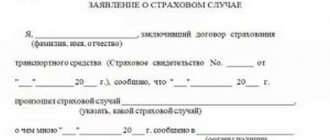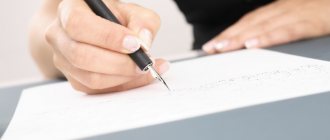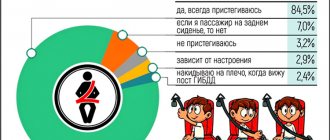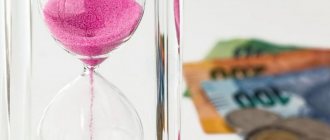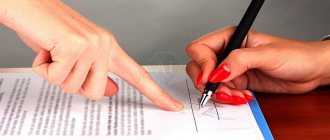Presumption of innocence
The Code of the Russian Federation on Administrative Offenses in Article 1.5 reveals the concept of the presumption of innocence of persons suspected of committing administratively punishable acts. What is the essence of the presumption of innocence:
- A driver can be punished only if his guilt in committing an unlawful act is established (Part 1). In this case, guilt can be either intentional or in the form of negligence.
- In order to find a driver guilty of a violation, it is necessary to prove his guilt as established by law and confirm it by a decision of an authorized traffic police officer or a court that has entered into legal force (Part 2).
- The suspected driver is not required to prove his innocence. The collection of evidence and establishment of guilt should be carried out by traffic police officers and the court (part 3). The exception concerns recording of violations by photo and video surveillance cameras.
- If there is the slightest doubt that the driver is guilty of committing an accident or other administrative offense, he is considered innocent (Part 4).
The most typical cases when it is necessary to prove innocence
Situations on the roads that lead to collisions are very diverse, so it is almost impossible to give universal recommendations. Next, I will look at how to prove innocence in the most common cases in which a dispute about guilt arises.
When an accident happened at an intersection
A wide variety of accidents occur at intersections, so the evidence will be the same as in any controversial road accident: video recording, witness testimony, examination of damage and a competent legal basis for innocence.
Usually the main aspect determining culpability in such situations is the answer to the question of who had the advantage. Very often, it is at intersections that accidents occur in which mutual fault is established.
If you were drunk at the time of the accident
Being intoxicated while driving a vehicle is a serious offense dangerous to others, for which the driver will be punished regardless of guilt in the accident. An official can make a conclusion about being drunk while driving only based on the results of a medical examination . Testimony of witnesses, etc., according to the decision of the Supreme Court, cannot be accepted as evidence of drunkenness.
Article on the topic: The whole truth about punishment for a drunk driving accident: when, for what and what it will be + accident statistics
But if alcohol is detected during the examination, it will be unequivocally decided that the driver was in such a state at the time of the accident. Therefore, do not drink alcohol or alcohol-containing products or medications after being involved in an accident until you have been examined.
Note. Being drunk in a car in a parking lot, according to the decision of the Supreme Court, is not an offense and therefore is not punishable.
When drunk driving is not the culprit
But alcohol intoxication does not always lead to an accident, for example, a reckless driver crashes into a car stopped at a traffic light, the driver of which is drunk. It is clearly clear that the person behind the wheel is innocent of the accident.
But it often happens that they try to pin all the blame for an accident on a drunk person, or to make the blame mutual. After all, he was drunk driving! In this case, however, as in any other case, it will be necessary to go to court, which will establish what exactly led to the accident and who is the culprit.
If you were avoiding a collision and got into an accident
Unfortunately, according to current rules, all you can do if there is a risk of collision is to brake in your lane. And very often those who avoid a collision, but still get into an accident, are declared the culprit, while the one who provoked the accident remains unpunished. And even in court it was almost impossible to prove innocence.
But it is worth noting that the practice in the courts has been changing recently. In such a situation, as always, video recordings and eyewitness testimony will serve well.
And during the trial, a traceological examination will be required. If during its conduct it is established that the actions of the driver avoiding the collision were the only correct ones in the current situation and contributed to mitigating the consequences of a possible accident, he will most likely be acquitted, or some degree of guilt will be established.
But it is still worth remembering that in the event of an emergency, it is more correct to hit the car that created the obstacle, of course, when it is not life-threatening, than to try to go around it with the risk of hitting other cars. Otherwise, you will have to prove your innocence, which is often not easy.
Article on the topic: Everything about a non-contact road accident: what is it, who is to blame and how to get compensation under compulsory motor liability insurance + judicial practice
Who is to blame for an accident with a pedestrian?
If a person crossed the road in the right place, and even when the traffic light was green, the blame, of course, falls entirely on the driver. But as you know, pedestrians do not always cross the roadway as expected.
Article on the topic: Who is to blame and what punishment does the culprit face if an accident happens at a pedestrian crossing + statistics on such accidents for 2016
What to do immediately after an accident
If you find yourself in such a situation, it is very important to capture the scene of the incident in a photo, which will prove the unsuitability of the place for crossing the road. If a crossing or intersection is visible from the scene of the accident, be sure to take photographs so that they can be seen, since a pedestrian is prohibited from crossing the road if a crossing or intersection is within sight.
Just as it is forbidden to cross the road if the driver’s view is blocked, etc. So one can give many examples when it is the pedestrian who violates the traffic rules, and therefore is the culprit. It is also important to correctly depict the diagram of the accident.
How to prove innocence
As always, DVR recordings and witness statements confirming the suddenness of a person’s appearance on the road and the circumstances (for example, a person was pushed) are of great help.
If you suspect that the pedestrian is drunk, demand that he be examined; this will also serve as an argument to prove your innocence.
Well, the most compelling evidence will be a forensic examination, which will establish whether the driver was speeding and whether he had the physical ability to stop the car.
When it skidded and a collision occurred
When skidding, it is very important to record the condition of the road surface and the environment. In such accidents, an automotive and road technical examination of the incident is needed. Moreover, the correct conclusion does not always follow from them. Interpreting clause 10.1 of the traffic rules, we can come to the conclusion that no matter how fast the driver drives, he will always be guilty, since the speed was too high for the traffic situation in question.
But from the regulatory documents relating to road traffic, it follows that the driver violates the rules only when the state (respectively, the road services) has created the conditions necessary for safe traffic, prescribed in the regulatory documents.
Consequently, proving the driver’s innocence comes down to justifying the failure of road services to fulfill their duties to create safe driving conditions, which is why the driver could not choose the right speed, and, in general, carry out safe movement.
Leaving the scene of an accident
Of course, leaving the scene of an accident is a serious offense and can have quite serious consequences. But there are also situations when the driver is charged with leaving the scene of an accident when he did not even think of doing so. It seems to me that all such cases can be divided into two groups.
There is no evidence of leaving the scene of the incident
I include those in the first category where it doesn’t matter whether a collision occurred or not, but the driver was declared a getaway, although in fact he did not break the law. For example, he left, but returned before the traffic inspectors arrived, moved the car, the drivers parted ways, having mutually agreed not to call the police, and then one of them nevertheless called the traffic police.
In this case, it is relatively easy to prove innocence. It is necessary to prove that the driver’s actions did not violate traffic rules. The main arguments could be:
- The presence of signatures of the accused driver on the documents about the accident, indicating that he was present when the incident was recorded.
- Availability of a receipt of no claims, an audio-video recording confirming the consent of the other driver to leave without calling the traffic police.
Article on the topic: Is it possible to leave the scene of an accident without breaking anything?
Unintentionally leaving the scene of an accident
In the second group, I include cases where the driver did not intentionally drive away after an accident, not knowing about the car touching or the presence of damage, the damage is absent or negligible. In this case, it is again proven that the driver committed an offense classified as leaving the scene of an accident, since:
- He could not have known about the accident.
- There was no accident.
- There is no convincing evidence that an offense has been committed.
Article on the topic: 4 ways to avoid liability for leaving the scene of an accident
Accidents during lane changes
Most often, such accidents occur in dense traffic flows, in populated areas. The basic rule is that the driver should not interfere with other vehicles when changing lanes. Therefore, the one who rebuilt is to blame.
The one on the left always gives way
And when changing lanes at the same time, the one on the left must yield. And, of course, it is necessary to turn on the turn signals. Therefore, if both colliding cars changed lanes, then the one on the left and/or who did not turn on the turn signals will be in the wrong. The fact of changing lanes is evidenced by the presence of parts of the car in several lanes, that is, when the car is standing above the marking line.
How to prove innocence during lane changes
In such accidents, it is necessary to immediately record the position of the vehicle relative to the markings at the moment of the collision. Based on how the vehicles were positioned at the time of the accident, it will be determined who was changing lanes, where, and, accordingly, who is to blame.
But sometimes a situation arises when the driver suddenly changed lanes and the collision occurred after the car of the person changing lanes was completely in your lane. In this case, to prove that your opponent was changing lanes, and you were moving straight, therefore, innocent, you will need a video recording from the recorder and testimony of witnesses, and sometimes a trace examination (when there are traces on the road or the fact of changing lanes can be determined by damage).
Who determines who is at fault in an accident?
The protocol on an administrative offense is submitted for consideration and a decision to impose punishment: to an authorized official of the State Traffic Safety Inspectorate (Article 20.3 of the Code of Administrative Offenses of the Russian Federation), to the court (Article 20.1 of the Code of Administrative Offenses of the Russian Federation).
If an administrative investigation is carried out in an accident case, then the decision about the guilt or innocence of the driver in committing it rests with the judicial authorities.
The document establishing guilt in an accident is a decision issued by a court or a traffic police officer. A protocol drawn up at the scene of the incident is necessary to record what happened and is one of the evidence in the case.
Having become a participant in an accident, it is important not to get confused, but to pay attention to the actions of the traffic police officers. If you disagree with any data in the protocol, write your objections, and remember that until guilt is legally established, the driver cannot be considered the culprit of the accident.
What is mutual fault in an accident?
As directly follows from the term, mutual guilt in an accident lies in the violation of traffic rules by both car owners at once. It is important that such violations actually lead to an accident, or increase its consequences, and are not of a formal nature. A typical example is that driving a car without wearing a seat belt is a clear violation of traffic rules, but it cannot cause an accident. To eliminate such controversial issues, when investigating cases, the cause-and-effect relationship is always studied and confirmed.
Determining the circumstances of mutual fault in an accident has the following features:
- if both participants voluntarily admit their guilt, it is allowed to draw up a notice according to the Euro Protocol scheme (naturally, if this complies with the conditions of Law No. 40-FZ);
- if a traffic police representative is called to the scene of the incident, he will confirm the fact of guilt by drawing up protocols;
- The inspector himself cannot determine the percentage of guilt of each of the violators, so this issue will have to be resolved at the stage of registration of insurance.
Note!
Mutual guilt in an accident can occur not only for two, but also for three, four or more drivers at the same time.
Cases of mass accidents arise regularly, and the consideration of such cases is characterized by increased complexity. We recommend that you always involve a lawyer in the preparation of documents when submitting documentation to insurance companies and to the court. The fact that two or more persons are at fault in an accident does not preclude the possibility of compensation for damage or harm. However, victims will have to undergo additional procedures, since the degree (percentage) of guilt must be confirmed.
How does responsibility arise when there is mutual guilt?
Punishment for violating traffic rules during a double-crossing occurs according to the general rules. The traffic police representative will fill out protocols for each violator, indicate the article of the law, transfer the materials to the court or make a decision on the spot (this depends on the type of violation). Each of the violators can file objections, defend interests in court, and send complaints. The procedures for bringing to justice for each of the perpetrators of an accident are carried out separately from each other.
If one of the car owners was able to prove his innocence, the compensation procedure changes radically. Since there will be only one culprit in an accident, the victim can contact his insurer and draw up documents according to the usual procedure. There are also special nuances when obtaining insurance if unintentional leaving the scene of an accident is established. You can learn more about this during a consultation with our lawyers.
When is it appointed?
During the administrative investigation, the same issues are resolved as at the scene of a car accident. However, analysis in case of an accident is necessary if a longer time is required to study all the circumstances of the incident or conduct various examinations. In other words, analysis of an accident is carried out if it is not possible to find out all the essential details directly at the scene of the accident that influence the determination of the guilt of the participants.
The most common cases that lead to an investigation are:
- causing minor, moderate or severe harm to human health as a result of an accident;
- presence of dead;
- controversial issues in the circumstances of the event;
- differences in views regarding the assessment of the causes of what happened by the participants in the accident;
- drivers denying guilt.
If there are victims with varying degrees of injuries in an accident, an operational investigation team consisting of operational police officers, an investigator and an expert is sent to the scene of the incident, in addition to the traffic police inspector. Such material is registered with the territorial police department as quickly as possible and sent to the appropriate authority depending on the consequences of the accident:
- to a specialized investigative department for the investigation of road accidents - in the event of the death of a person or serious harm to health;
- to the local department of the State Traffic Inspectorate - in the presence of mild or moderate harm to human health.
An investigation is mandatory in cases of accidents involving drivers who have government ranks or foreign citizenship.
Review group: who is included in it?
The analysis of road accidents is usually carried out by a separate unit - these are administrative specialists, whose actions are focused on a detailed analysis of road accidents throughout the area. Each traffic police department has its own group, whose task is to objectively compare all the factors that led to the accident and determine the degree of guilt of each participant.
The appearance of each of the participants in the accident in the analysis team’s office is optional; the decision can be made in the absence of both parties. However, by being present at the study of the accident in person, you can confirm that you are right and demand justice.
When considering a case, it is important to provide some evidence of your innocence. Such supporting facts may include witness testimony, as well as photo and video materials. Many drivers make the mistake of inviting the traffic police officer to add evidence to the case directly at the scene of the accident, orally. Often the employee simply forgets about the request, and the materials remain out of sight of the review team.
Remember: Article 51 of the Constitution of the Russian Federation provides you with the right not to incriminate yourself.
What is an accident investigation and when is it carried out?
Drivers who get into accidents on the roads, in addition to actions in accordance with the traffic rules of the Russian Federation and the agreement with the insurance company, face another unpleasant procedure - analysis of the accident at the traffic police department.
As a rule, in driving schools, motorists are given theoretical and practical knowledge of driving vehicles, but not everyone knows how to behave during an accident investigation at the traffic police. Beginners get completely lost in such situations, so we decided to devote a separate article to this topic. We will tell you how long it takes to analyze an accident at the traffic police, what is the procedure for this procedure and how to cancel the protocol with its help?
Drawing up a protocol Road users involved in accidents call traffic police officers to document the incident.
Time frame for consideration of the case
A review of an accident that has occurred is scheduled within 3 to 30 days from the date of the accident. It all depends on the complexity of the case and the necessary measures. Sometimes the period can be more than 30 days, but there are legal reasons for this.
Read more: Licensing activities for waste recycling
During the specified period, the group studies the materials that were received after the accident, conducts interviews with witnesses and participants. In some cases, photo and video recording is required.
If there are victims, this procedure necessarily includes their undergoing a medical examination. It allows you to determine the extent of damage and damage to health. A medical report, which can only be obtained after completion of treatment, is also tied to the case. In such cases, an extension of the specified monthly period up to 6 months will be required.
What to do if the traffic police has not identified those responsible for the accident?
Another case where the role of accident notification comes to the fore. The fact is that according to Russian laws, such nonsense as “a road accident without a culprit” is formally possible. More precisely, an accident always occurs due to the fact that someone violated the Traffic Rules, but administrative liability is not always provided for this violation - an example would be paragraph 10.1 of the traffic rules, when the driver lost control without exceeding the speed limit. And if there is no administrative punishment, then civil liability does not arise, and with it, no formal reason for payment under compulsory motor liability insurance. In other words, an accident may have both a perpetrator and a victim with a full set of documents from the traffic police, but if they do not contain the fact of administrative punishment, the insurance company will have a reason to refuse payment under compulsory motor liability insurance, and then compensation for the damage will have to go through the court.

